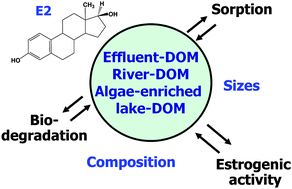Changes in the sorption and rate of 17β-estradiol biodegradation by dissolved organic matter collected from different water sources
Abstract
The potential biodegradation and subsequent transformation of 17β-estradiol (E2) to

* Corresponding authors
a
School of Environmental Science and Engineering, Gwangju Institute of Science and Technology (GIST), 261 Cheomdan-Gwagiro, Buk-gu, Gwangju, Korea
E-mail:
sdkim@gist.ac.kr
Fax: +82 62-970-2434
Tel: +82 62-970-2445
b Department of Agro-Food safety, National Academy of Agricultural Science, Rural Development Administration, 150 Suin-ro, Kweonseon-gu, Suwon, Korea
c Department of Applied Sciences, London South Bank University, 103 Borough Road, London, UK
d Department of Environmental Engineering, University of Ulsan, 29 Mugeo-dong, Nam-gu, Ulsan, South Korea
The potential biodegradation and subsequent transformation of 17β-estradiol (E2) to

 Please wait while we load your content...
Something went wrong. Try again?
Please wait while we load your content...
Something went wrong. Try again?
J. H. Lee, J. L. Zhou, Y. Lee, S. Oh and S. D. Kim, J. Environ. Monit., 2012, 14, 543 DOI: 10.1039/C1EM10690B
To request permission to reproduce material from this article, please go to the Copyright Clearance Center request page.
If you are an author contributing to an RSC publication, you do not need to request permission provided correct acknowledgement is given.
If you are the author of this article, you do not need to request permission to reproduce figures and diagrams provided correct acknowledgement is given. If you want to reproduce the whole article in a third-party publication (excluding your thesis/dissertation for which permission is not required) please go to the Copyright Clearance Center request page.
Read more about how to correctly acknowledge RSC content.
 Fetching data from CrossRef.
Fetching data from CrossRef.
This may take some time to load.
Loading related content
